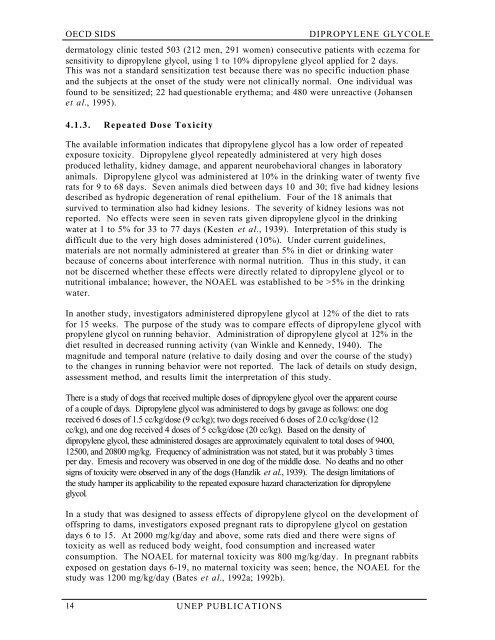Dipropylene glycol (SIDS)
Dipropylene glycol (SIDS)
Dipropylene glycol (SIDS)
You also want an ePaper? Increase the reach of your titles
YUMPU automatically turns print PDFs into web optimized ePapers that Google loves.
OECD <strong>SIDS</strong><br />
DIPROPYLENE GLYCOLE<br />
dermatology clinic tested 503 (212 men, 291 women) consecutive patients with eczema for<br />
sensitivity to dipropylene <strong>glycol</strong>, using 1 to 10% dipropylene <strong>glycol</strong> applied for 2 days.<br />
This was not a standard sensitization test because there was no specific induction phase<br />
and the subjects at the onset of the study were not clinically normal. One individual was<br />
found to be sensitized; 22 had questionable erythema; and 480 were unreactive (Johansen<br />
et al., 1995).<br />
4.1.3. Repeated Dose Toxicity<br />
The available information indicates that dipropylene <strong>glycol</strong> has a low order of repeated<br />
exposure toxicity. <strong>Dipropylene</strong> <strong>glycol</strong> repeatedly administered at very high doses<br />
produced lethality, kidney damage, and apparent neurobehavioral changes in laboratory<br />
animals. <strong>Dipropylene</strong> <strong>glycol</strong> was administered at 10% in the drinking water of twenty five<br />
rats for 9 to 68 days. Seven animals died between days 10 and 30; five had kidney lesions<br />
described as hydropic degeneration of renal epithelium. Four of the 18 animals that<br />
survived to termination also had kidney lesions. The severity of kidney lesions was not<br />
reported. No effects were seen in seven rats given dipropylene <strong>glycol</strong> in the drinking<br />
water at 1 to 5% for 33 to 77 days (Kesten et al., 1939). Interpretation of this study is<br />
difficult due to the very high doses administered (10%). Under current guidelines,<br />
materials are not normally administered at greater than 5% in diet or drinking water<br />
because of concerns about interference with normal nutrition. Thus in this study, it can<br />
not be discerned whether these effects were directly related to dipropylene <strong>glycol</strong> or to<br />
nutritional imbalance; however, the NOAEL was established to be >5% in the drinking<br />
water.<br />
In another study, investigators administered dipropylene <strong>glycol</strong> at 12% of the diet to rats<br />
for 15 weeks. The purpose of the study was to compare effects of dipropylene <strong>glycol</strong> with<br />
propylene <strong>glycol</strong> on running behavior. Administration of dipropylene <strong>glycol</strong> at 12% in the<br />
diet resulted in decreased running activity (van Winkle and Kennedy, 1940). The<br />
magnitude and temporal nature (relative to daily dosing and over the course of the study)<br />
to the changes in running behavior were not reported. The lack of details on study design,<br />
assessment method, and results limit the interpretation of this study.<br />
There is a study of dogs that received multiple doses of dipropylene <strong>glycol</strong> over the apparent course<br />
of a couple of days. <strong>Dipropylene</strong> <strong>glycol</strong> was administered to dogs by gavage as follows: one dog<br />
received 6 doses of 1.5 cc/kg/dose (9 cc/kg); two dogs received 6 doses of 2.0 cc/kg/dose (12<br />
cc/kg), and one dog received 4 doses of 5 cc/kg/dose (20 cc/kg). Based on the density of<br />
dipropylene <strong>glycol</strong>, these administered dosages are approximately equivalent to total doses of 9400,<br />
12500, and 20800 mg/kg. Frequency of administration was not stated, but it was probably 3 times<br />
per day. Emesis and recovery was observed in one dog of the middle dose. No deaths and no other<br />
signs of toxicity were observed in any of the dogs (Hanzlik et al., 1939). The design limitations of<br />
the study hamper its applicability to the repeated exposure hazard characterization for dipropylene<br />
<strong>glycol</strong>.<br />
In a study that was designed to assess effects of dipropylene <strong>glycol</strong> on the development of<br />
offspring to dams, investigators exposed pregnant rats to dipropylene <strong>glycol</strong> on gestation<br />
days 6 to 15. At 2000 mg/kg/day and above, some rats died and there were signs of<br />
toxicity as well as reduced body weight, food consumption and increased water<br />
consumption. The NOAEL for maternal toxicity was 800 mg/kg/day. In pregnant rabbits<br />
exposed on gestation days 6-19, no maternal toxicity was seen; hence, the NOAEL for the<br />
study was 1200 mg/kg/day (Bates et al., 1992a; 1992b).<br />
14<br />
UNEP PUBLICATIONS
















